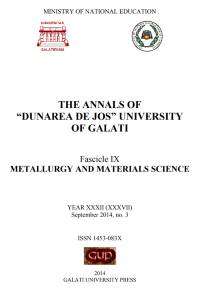Challenges in Corrosion Protection Using Vegetable Extracts as Inhibitors - Electrochemical Studies
Abstract
Corrosion is an irreversible chemical or electrochemical reaction of a material with its surrounding environment or medium which results in consumption of the material or in dissolution into the material of a component of the environment. Corrosion can provoke severe and expensive destructions in any field of activity from transportation, home appliances, water and gas alimentary systems, energy production systems, chemistry, metallurgy, semi-finished production, bridges and public buildings, etc. The main important reasons of corrosion phenomena study are: economics, safety and conservation. The economic point of view includes the cost of material losses resulting from the above activity fields and may involve piping, tanks, ships, hulls, marine structures, etc. The corrosion costs also include the losses of energy and water reserves accompanying the production of metals and the need for expensive replacements for the corroded ones. Unexpected failures of equipment and devices because of weakening of structures induced by corrosion may reduce the safety criterion, which in the design of equipment for nuclear power plants and for disposal of nuclear wastes is critical. The effects of corrosion on the safe, reliable and efficient operation of equipment or structures are often more serious than the simple loss of a mass of metal. Finally, the third important consideration for which the corrosion phenomena must be studied is conservation of mineral and metal resources, whose world supply is limited. Several techniques have been applied to protect metallic structures against corrosion. One of the most important methods in that regard is the use of corrosion inhibitors. A corrosion inhibitor is a chemical substance that, when added in small concentration to an environment effectively prevents or decreases the corrosion rate. Inhibitors slow down the corrosion process by: increasing the anodic or cathodic polarization behavior, reducing the movement or diffusion of ions to the metallic surface and increasing the electrical resistance to the metallic surface. The paper presents some experimental results with vegetable extracts acting as corrosion inhibitors for carbon steel and copper in acidic and neutral environments.
Downloads
References
[2]. Benea Lidia - Chimie generală, Editura Academica, 2009, ISBN: 978-973-8937-45-1.
[3]. Benea Lidia - Curs anul III - Electrochimie şi coroziune.
[4]. Benea Lidia - Electodepuneri compozite în teorie şi practică, Editura Porto- Franco Galaţi, 1998, ISBN: 973-557-490-X.
[5]. E. A. Noor - Potential of aqueous extract of Hibiscus sabdariffa leaves for inhibiting the corrosion of aluminum in alkaline solutions, Journal of Applied Electrochemistry, 39 (9), 2009, p. 1465-1475.
[6]. D. G. Ladha, U. J. Naik, N. K. Shah - Investigation of Cumin (Cuminum Cyminum) extract as an eco-friendly green corrosion inhibitor for pure Aluminium in Acid medium, Journal ofMaterials Environmental Science, 4 (5), 2013, p. 701-708.
[7]. E. E. Oguzie, C. K. Enenebeaku, C. O. Akalezi, S. C. Okoro, A. A. Ayuk, E. N. Ejike - Adsorption and corrosioninhibiting effect of Dacryodis edulis extract on low-carbon-steel corrosion in acidic media, Journal of Colloid and interface Science, 349 (1), 2010, p. 238-292.
[8]. I. B. Obot, N. O. Obi-Egbedi, S. A. Umoren, E. E. Ebenso - Synergistic and antagonistic effects of anions and ipomoea invulcrata as green corrosion inhibitor for aluminium dissolution in acidic medium, International Journal of Electrochemical Science, 5(7), 2010, p. 994-1007.
[9]. A. K. Satapathy, G. Gunasekaran, S. C. Sahoo, Kumar Amit, P. V. Rodrigues - Corrosion inhibition by Justicia gendarussa plant extract in hydrochloric acid solution, Corrosion Science, 51, Issue 12, p. 2848-2856.
[10]. Olusegun K. Abiola, J. O. E. Otaigbe - The effects of Phyllanthus amarus extract on corrosion and kinetics of corrosion process of aluminum in alkaline solution, Corrosion Science, 51, Issue 11, 2009, p. 2790-2793.
[11]. Bei Qian, Baorong Hou, Meng Zheng - The inhibition effect of tannic acid on mild steel corrosion in seawater wet/dry cyclic conditions, Corrosion Science, 72, July 2013, p. 1-9.
[12]. F. Bentiss, M. Bouanis, B. Mernari, M. Traisnel, H. Vezin, M. Lagrenee - Understanding the adsorption of 4H-1,2,4-triazole derivatives on mild steel surface in molar hydrochloric acid, Appliled Surface Science, 253, 2007, p. 3696.



